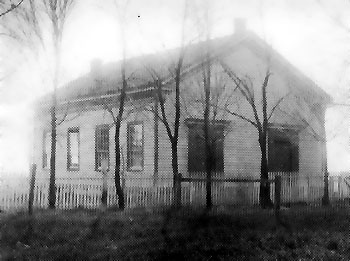

|
The Diagonal Road Church |

|
|
HISTORICAL HIGHLIGHTS |
| The beginnings of the first church, on Wadsworth Road, go back to 1851 with the arrival of the four families of Mennonites from the Montgomery-Berks County area of Pennsylvania, and the family of Rev. Ephraim Hunsberger who came a year later in 1852. Rev. Hunsberger immediately began to organize a church. Ground was purchased one fourth mile out on Wadsworth Road (Diagonal Rd.) from Rt. 97 where the little cemetery still remains. |
| Construction began in the spring of 1853 to erect a simple, frame building 32x42 feet. Facing the east, the church was built with the usual plan of Mennonite churches, with two front entrances, one for men and one for women, entering into their respective anterooms. From these, doors led into the main sanctuary. The altar platform was raised about a foot along the west end, with the elderly people sitting on the Absatz at right angles to the audience, the men on the north and the women on the south. A partition as high as the benches divided the men and women on the main floor. Pulpit furniture was plain, painted white, composed of a few chairs and a reading desk. Two stoves provided heat in winter. The church had four windows on each side, a picket fence enclosure, and a number of young trees across the front. |
| The church was dedicated, debt free (with the help of Pennsylvania brethren), on Saturday and Sunday, Oct. 8-9, 1853. Guests from Pennsylvania were Rev. Christian Clemmer, Rev. William Shelly and Jacob Meschtner. Local churches were represented by Rev. Klein, Lutheran, and Rev. Ham of the Reformed Church. Henry Nice was ordained as assistant minister and Jonas Nice as deacon. A catechetical class of twelve was baptized, who, with the five known couples (10 charter members), comprised the early church membership. |
| The church prospered under the progressive leadership of Rev. Hunsberger who held services in German every other Sunday; instituted the Sunday School (1854); influenced church unity and effective denominational fellowship; signed the articles of constitution for the General Conference Mennonite Church; and instituted plans for the first Mennonite college in America. With the close of that college in 1878 and the loss of influence in spiritual stimulation and cultural activity because students, professors and their families moved away, the church membership and functions declined. By 1890 contact with sister churches was less frequent; the Sunday School disbanded. Unable to cope with changing conditions and demands of many members who now lived closer to town, adopting new habits and practices of their neighbors, and desiring English speaking worship services, the aging Rev. Hunsberger resigned. The congregation called his assistant, energetic Noah Hirschy, who revitalized the church with English services and new innovations and moved the church to the center of town. |
| The old church was used by Rev. Hunsberger in offi- ciating at funerals of many friends laid to rest in the cemetery, and on special occasions, until 1900, when it was decided to dismantle the building. The $40 from the sale of lumber was used for cemetery maintenance. (Some lumber was used to build a porch on a S. Main Street residence). |
| The old pulpit, built by John Heckman between 1875- 1880 for this church, was offered by the College Street Church, in 1902, to any new congregation desiring it, since they had a new one built by Nelson Hard (in our possession). It was accepted by the Deer Creek Mennonite Church, Okla. In addition to being used by Wadsworth pastors, Ephraim Hunsberger, N.C. Hirschy, and A.J. Kliewer, the old pulpit served nine ministers at Deer Creek. In 1952 the Oklahoma congregation moved into a new edifice and the pulpit was no longer used. It was donated in February, 1967, to the Kauffman Museum, at Bethel College, N. Newton, Kansas, where it is today. |
| The old cemetery on Wadsworth Road is maintained by endowment fund; grounds were reopened with lots available for a nominal fee, plus opening and closing costs. At the time when this was first written (1952) Elton Beery, sexton, had cared for the cemetery grounds for twenty years, an expression of dedicated interest in the resting place of our founder and many other church leaders. |